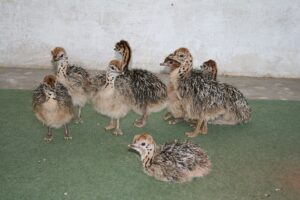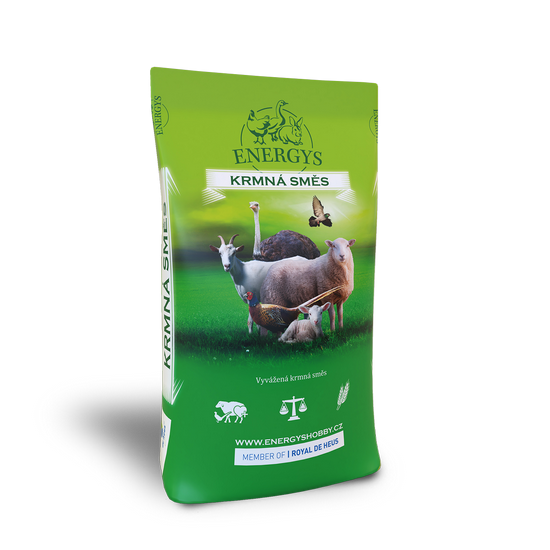Rabbits
Poultry
Laying hens
Quails
Guinea pigs
Pigs
Ostriches
Sheep and goats
Pigeons
Pheasants
Forest animals
Ostrich farming
The farming of the double-fingered ostrich for the production of feathers, skin meat and eggs began in the mid-19th century in africa. Commercial breeding of the largest flightless bird on the planet began in the 1990s.
Feeding ostriches
On farms, the birds are housed in airy barns with an adjoining grass run. Pasture is the basis of the ostrich diet from about the end of april until mid-november. As grazing forage declines, the birds are given alfalfa grass hay, supplemented with a vitamin-mineral premix.
The feed ration also includes, of course, kernels, or grain (wheat and barley) at a daily rate of half to one kilogram per bird, with which, especially after a long winter, farmers compensate for the birds’ energy deficit. In january, they start adding oats and pelleted feed to the ostriches to support laying. From mid-april onwards, green fodder (alfalfa grass) appears in the ration. The feed, together with the lengthening of the day, will kick-start laying during february and march.
Raising ostriches on farms
Ostriches lay an average of 30 to 40 eggs, with bred lines laying 80 to 120 eggs. The eggs are placed in hatching boxes where they are incubated at 36,3 °c for six weeks. A similar temperature should be maintained for the ostriches during their first days in the nursery.
boxes where they are incubated at 36,3 °c for six weeks. A similar temperature should be maintained for the ostriches during their first days in the nursery.
The hatched ostriches are initially kept in the nursery under an infralamp and on heated mats. Feeding begins after the yolk sac is digested, which is about the fourth or fifth day after incubation. From the age of three months, the chicks are on pasture, where they have a complete feed mixture in addition to the green feed. At night they are confined to a mobile air stable. From the age of six months, the birds can tolerate temperature drops below freezing without any problems.
Ostriches reach sexual maturity at two to three years, with roosters maturing later. Ostriches destined for slaughter end their life journey at about one year of age. A 100 kg ostrich yields approximately 30 kg of meat; the so-called commercial meat comes exclusively from the thighs, while the meat from the other parts of the body is used to make sausages.
In addition to the meat, the skin can also be recovered and used,
For example, to make luxury shoes, handbags, bags, clothing, wallets and other accessories. Ostrich feathers are also of interest as fashion accessories. The shells are used either whole for making lamps, cups, etc., or as fragments in the form of decorative items. Ostrich fat is used to make original natural cosmetics.
Related posts
6. April 2022
The farming of the double-fingered ostrich for the production of feathers, skin meat and eggs began in the mid-19th century in africa. Commercial breeding of the largest flightless bird on the planet began in the 1990s.
21. August 2019
The African ostrich was domesticated during the second half of the previous century in South Africa. Domesticated ostriches have been reared on Czech farms for their meat, leather and feathers since 1993. How egg laying and hatching take place? And what are the most frequent issues affecting ostriches?
15. August 2019
Just twenty five years ago no one would have believed that there would be ostrich farms in this country. Which species of large flightless bird are suitable for farming and what should you feed them?
Related products

OSTRICH REPRO
A supplementary feed for ostriches in the laying period. Add an additional 20% of dry fodder or up to 50% of green fodder. Thanks to a high content of chosen substances it supports fertility and higher hatching.

OSTRICH MAXI
A supplementary feeding mix for weaning and fattening ostriches from 6 months to achieval of sexual adulthood or slaughter. Supports fast growth, high meat content and excellent taste. Add a high quality bulky protein feed to the mix.

OSTRICH MINI
A complete feed for the starting phase of weaning and fattening ostriches. Use it from hatching to 6 months of age. After the period given it is advantageous to continue with fattening with the Ostrich MAXI mix. It does not contain coccidosistats.

OSTRICH UNI
A supplementary feeding mix for ostrich breeds in the non hatching period. Cereals and bulky feeds are added to the mix. This feed totally covers the need for vitamins and minerals.
